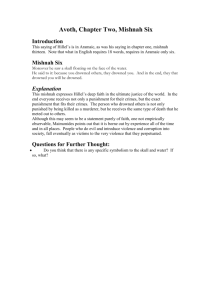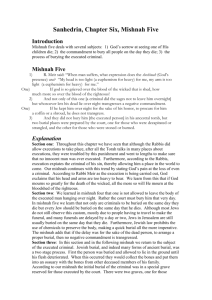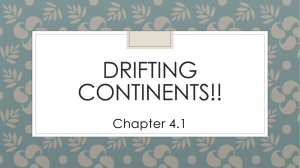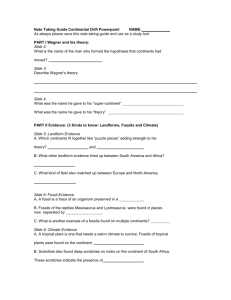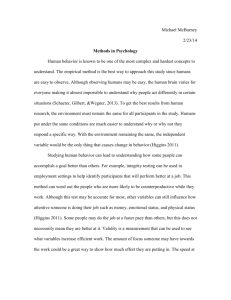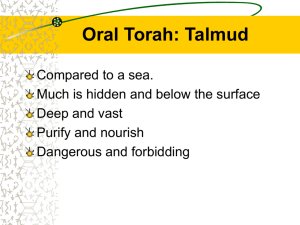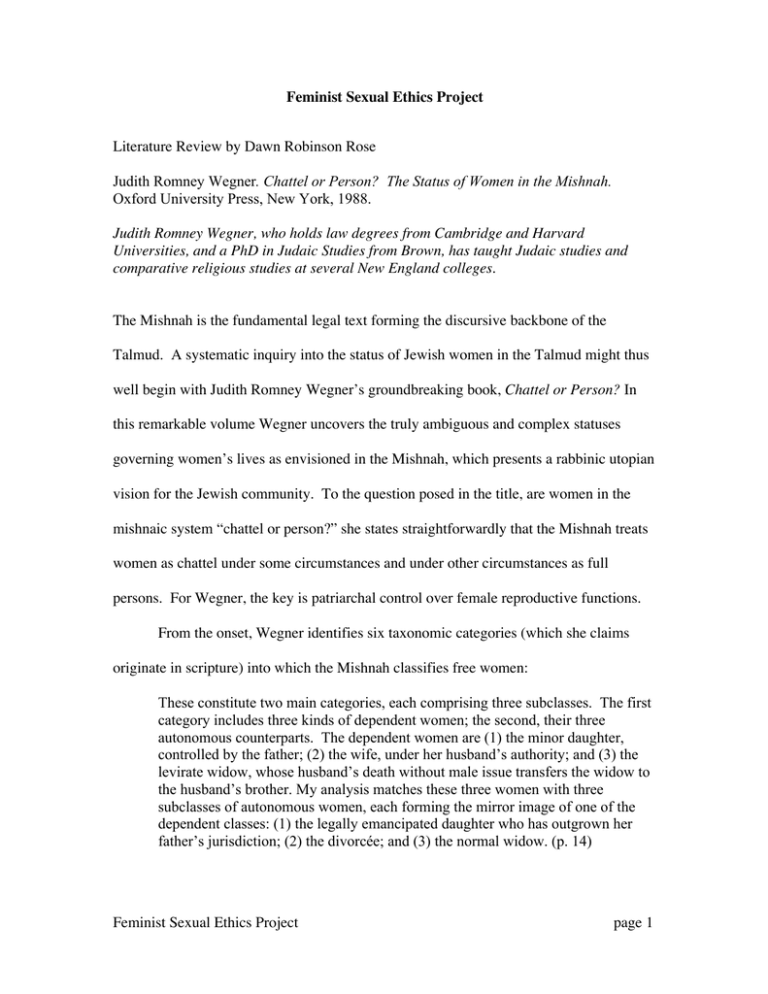
Feminist Sexual Ethics Project
Literature Review by Dawn Robinson Rose
Judith Romney Wegner. Chattel or Person? The Status of Women in the Mishnah.
Oxford University Press, New York, 1988.
Judith Romney Wegner, who holds law degrees from Cambridge and Harvard
Universities, and a PhD in Judaic Studies from Brown, has taught Judaic studies and
comparative religious studies at several New England colleges.
The Mishnah is the fundamental legal text forming the discursive backbone of the
Talmud. A systematic inquiry into the status of Jewish women in the Talmud might thus
well begin with Judith Romney Wegner’s groundbreaking book, Chattel or Person? In
this remarkable volume Wegner uncovers the truly ambiguous and complex statuses
governing women’s lives as envisioned in the Mishnah, which presents a rabbinic utopian
vision for the Jewish community. To the question posed in the title, are women in the
mishnaic system “chattel or person?” she states straightforwardly that the Mishnah treats
women as chattel under some circumstances and under other circumstances as full
persons. For Wegner, the key is patriarchal control over female reproductive functions.
From the onset, Wegner identifies six taxonomic categories (which she claims
originate in scripture) into which the Mishnah classifies free women:
These constitute two main categories, each comprising three subclasses. The first
category includes three kinds of dependent women; the second, their three
autonomous counterparts. The dependent women are (1) the minor daughter,
controlled by the father; (2) the wife, under her husband’s authority; and (3) the
levirate widow, whose husband’s death without male issue transfers the widow to
the husband’s brother. My analysis matches these three women with three
subclasses of autonomous women, each forming the mirror image of one of the
dependent classes: (1) the legally emancipated daughter who has outgrown her
father’s jurisdiction; (2) the divorcée; and (3) the normal widow. (p. 14)
Feminist Sexual Ethics Project
page 1
Wegner contends that “ownership” or “exclusive rights to” a woman’s reproductive
function are the decisive factor in the above taxonomic system. When no man has a right
to those functions, a woman is treated as an autonomous human being. When those
rights do exist, she is to one degree or another, chattel.
The female lowest on the rungs of autonomy and status in this system is the minor
daughter. As Wegner bluntly explains, “She is a sexual chattel.” (p. 21) She has a market
price [200 zuz] if her virginity is delivered intact. If a man rapes or seduces her, he must
pay the father the price for damaging his goods. If a bridegroom pays the 200 zuz and
then discovers his wife is not a virgin, he can sue the father. The rabbis of the Mishnah
delineate very clearly when a bridegroom can legally expect his bride to be a virgin and
when he cannot.1 Women who cannot be expected to be virgins include converts, freed
captives, or former slaves, for it is presumed that women from these social backgrounds
will have been promiscuous and/or preyed upon by men. If a girl were sexually assaulted
before the age of three years and a day, rabbinic medicine determined that the hymen
healed itself (or regenerated) and so upon puberty virginity was again intact (and the girl
could claim full bride-price). Wegner notes that the rabbis utilize external, social factors
to determine the virginity status of women and girls instead of physical examination. In
her estimation, it is part of a worldview that considers girls and women sexual chattel. If
these females were in these life situations, then they were most certainly used as sex
objects and therefore their worth on the market has declined dramatically.
1
Mishnah Ketubot 1:2–4.
Feminist Sexual Ethics Project
page 2
In considering the cases of rape and seduction of a minor daughter, Wegner finds
further evidence of paternal ownership over the daughter’s sexuality.2 For example, in
the case of seduction a perpetrator pays for shame and blemish. A closer reading of
Mishnah Ketubot 3:7 reveals that not only are the actual moneys for the damages paid to
the father, but the shame is according to his status in the community, not hers. The
amount for “blemish” is calculated according to the differential between an enslaved
virgin who is put up for sale and an enslaved woman who is no longer a virgin.
According to Wegner, the Mishnah goes on to delineate in various ways the minor
daughter’s lack of basic rights, underscoring the absoluteness of her father’s authority.
The father owns everything she finds, can collect the fruits of her labor, and most
significantly, can determine whom she will marry without her consent.3 In return,
according to the Mishnah, she is not even entitled to basic maintenance.4
To become married, then, is a step up on the ladder of selfhood. At this stage
there are ways in which a woman is chattel and ways in which she is a legal person.
Wegner identifies the former as relating to those biological functions that enable men to
fulfill the Torah’s command to be fruitful and multiply.
The most striking example of a wife’s chattel status is the fact that she is acquired
like property.5 Another illustration of her lack of agency is the unilateral nature of the
espousal ceremony. In the standard format, the man makes a formal declaration and the
2
One might compare Wegner’s analysis with that of Judith Hauptman, Rereading the Rabbis: A Woman’s
Voice (Boulder, CO: Westview, 1998), who presents the rabbis of the Mishnah as far more sympathetic to
the victim of sexual assault.
3
Mishnah Ketubot 4:4–5.
4
Mishnah Ketubot 4:6.
5
Mishnah Kiddushin 1:1. I have added the following mishnayot in this chapter for comparison. They are
also on acquisition, and are obviously included in this tractate on Kiddushin because they are on
acquisition.
Feminist Sexual Ethics Project
page 3
woman makes no reply.6 Given the unilateral nature of the engagement, Wegner finds it
unsurprising that divorce follows the same pattern of male prerogative.
Wegner considers the ordeal for the “straying wife” as prescribed by Mishnah
Sotah as “[p]erhaps the most graphic depiction of a wife as her husband’s sexual
property” (p. 50). Once again the action is unilateral; there is no corresponding ordeal for
men. Indeed, unfaithful husbands are not even a category of misdeed in mishnaic
thought. It is of great importance to note that this is the only trial by ordeal in biblical or
mishnaic law and that the procedure circumvents the normal rules of evidence. And what
is the ordeal set to determine? Wegner believes it has two functions: to determine if the
wife has had intercourse with another man; and, if she has, to detect and abort any fetus
that may have resulted from that union. In this way, the husband’s sexual rights and his
reproductive priority are protected. What may have looked like a moral drama
concerning guilt and innocence in fact boils down to male rights of property, access, and
use.
On the other hand, outside of her sexual and reproductive self, the mishnaic
system regards the wife as a legal person. She has “a right to maintenance by her
husband, who must supply food, clothing,7 and the rights of conjugal cohabitation”8 (p.
70). Also, should the marriage end, she generally retains the right to the payment set
down in her marriage contract (ketubah). Additionally, she is owed certain kindnesses,
such as permission to visit her parents, eat her favorite foods, and wear her favorite
ornaments. If he does not do these things, the husband may be found guilty of cruelty
6
Mishnah Kiddushin 2:3.
Mishnah Ketubot 5:8.
8
Mishnah Ketubot 5:6.
7
Feminist Sexual Ethics Project
page 4
and may be forced to give her a divorce and pay off her ketubah. Moreover, a wife can
own, buy and sell property, function as an agent, and bring or defend a lawsuit.
Thus we see clearly, the wife is no mere chattel. She has rights and agency. It is
only in regard to her sexuality and reproductive functions that she is unable to be selfdetermining. And it is in the category of full legal person with rights and agency that
Wegner understands the mishnaic laws concerning divorce in which a wife--through
moral error--has forfeited her ketubah. In the case where the husband tries to treat the
wife as chattel and divorce her for no good reason, the rabbis find in her favor and force
him to pay the full ketubah. They will not allow her to be treated entirely as chattel. In
the case where the wife has committed grievous sin and thereby may be divorced, the
rabbis hold her up as adult and thereby accountable. She is divorced and her ketubah is
forfeited.9 Wegner understands this level of moral accountability as a sign of Jewish
personhood.10
There are three types of autonomous woman under mishnaic law: the emancipated
daughter, the divorcée, and the widow. In regard to these categories, Wegner explains,
“A woman’s freedom from male authority rests precisely on the fact that no man can lay
claim on her sexuality” (p. 114). It is her hypothesis that, “in the private domain the
Mishnah’s framers always treat autonomous women as persons, never as chattels” (p.
115). She may arrange her own marriage (though the betrothal formula is still to be
spoken by the male). She can engage in litigation and in some instances serve as a
witness (but this later point is true about nearly all adult women). She can make a
religious vow without the fear that a man who is sovereign over her will break it for her.
9
Mishnah Ketubot 7:6.
This, I think, can be disputed. Slaves may be held variously accountable for certain crimes and thereby
liable for punishment.
10
Feminist Sexual Ethics Project
page 5
A divorcee is free to marry whomever she will.11 A widow is to be maintained from her
deceased husband’s estate.12 Thus, in the private domain an autonomous woman has
rights and privileges similar to that of a man’s.
This is not the case in the public sphere. Here Wegner argues that all women
regardless of their status were barred from participation in public religious rituals.
Although there is no outright explanation of this, she finds four themes that effect this
outcome in rabbinic life: (1) a legal presumption that men can and do perform religious
precepts on behalf of household members who cannot; (2) a tacit understanding that
women are best kept to the private sphere; (3) a legalistic rationalization that women,
who are not obligated to perform religious rituals and tasks cannot then do so for others;
and (4) a fear of women as “sexually disturbing and dangerously contaminating creatures
who must be barred from the public domain lest their presence distract men from
intellectual and spiritual pursuits” (p. 148).
This book will long remain a foundational text for feminist sexual ethics.
http://www.brandeis.edu/projects/fse/
11
Mishnah Gittin 9:1.
Mishnah Ketubot 11:1.
12
Feminist Sexual Ethics Project
page 6

